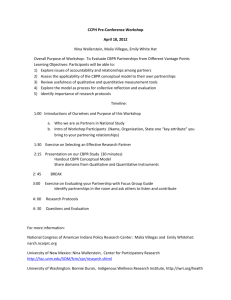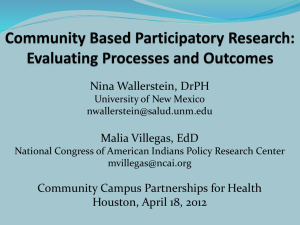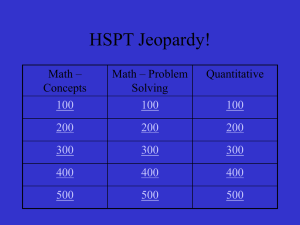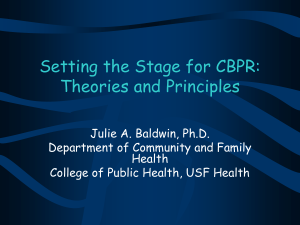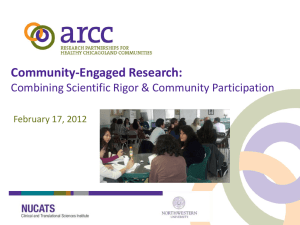Perceived impact of human subjects protection training on
advertisement
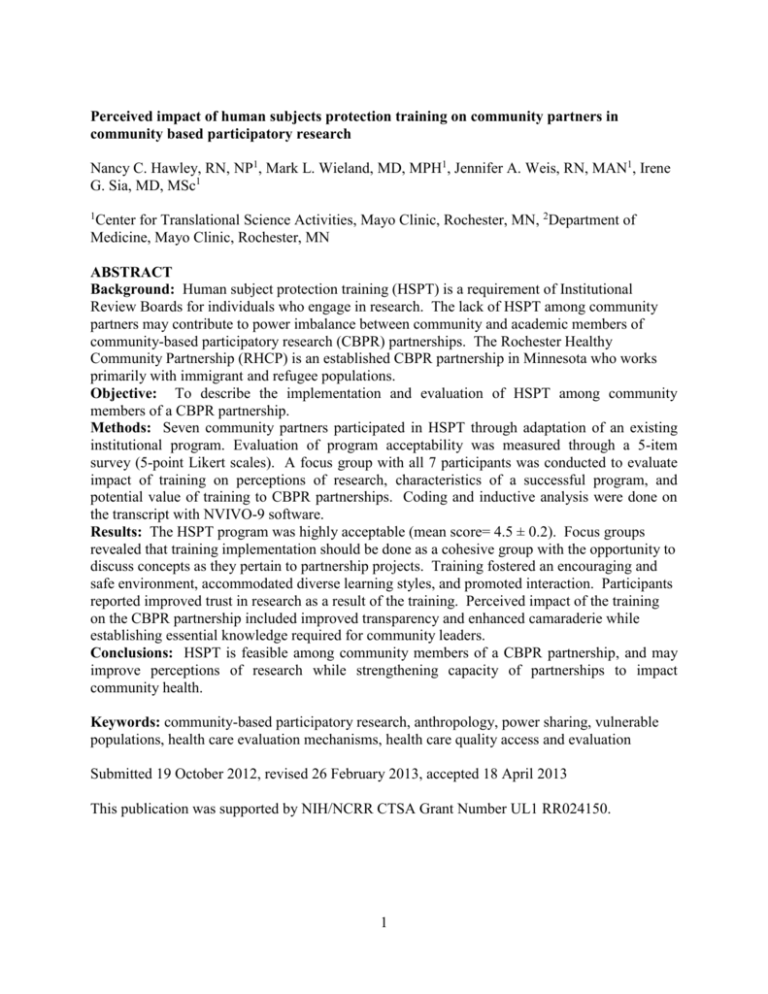
Perceived impact of human subjects protection training on community partners in community based participatory research Nancy C. Hawley, RN, NP1, Mark L. Wieland, MD, MPH1, Jennifer A. Weis, RN, MAN1, Irene G. Sia, MD, MSc1 1 Center for Translational Science Activities, Mayo Clinic, Rochester, MN, 2Department of Medicine, Mayo Clinic, Rochester, MN ABSTRACT Background: Human subject protection training (HSPT) is a requirement of Institutional Review Boards for individuals who engage in research. The lack of HSPT among community partners may contribute to power imbalance between community and academic members of community-based participatory research (CBPR) partnerships. The Rochester Healthy Community Partnership (RHCP) is an established CBPR partnership in Minnesota who works primarily with immigrant and refugee populations. Objective: To describe the implementation and evaluation of HSPT among community members of a CBPR partnership. Methods: Seven community partners participated in HSPT through adaptation of an existing institutional program. Evaluation of program acceptability was measured through a 5-item survey (5-point Likert scales). A focus group with all 7 participants was conducted to evaluate impact of training on perceptions of research, characteristics of a successful program, and potential value of training to CBPR partnerships. Coding and inductive analysis were done on the transcript with NVIVO-9 software. Results: The HSPT program was highly acceptable (mean score= 4.5 ± 0.2). Focus groups revealed that training implementation should be done as a cohesive group with the opportunity to discuss concepts as they pertain to partnership projects. Training fostered an encouraging and safe environment, accommodated diverse learning styles, and promoted interaction. Participants reported improved trust in research as a result of the training. Perceived impact of the training on the CBPR partnership included improved transparency and enhanced camaraderie while establishing essential knowledge required for community leaders. Conclusions: HSPT is feasible among community members of a CBPR partnership, and may improve perceptions of research while strengthening capacity of partnerships to impact community health. Keywords: community-based participatory research, anthropology, power sharing, vulnerable populations, health care evaluation mechanisms, health care quality access and evaluation Submitted 19 October 2012, revised 26 February 2013, accepted 18 April 2013 This publication was supported by NIH/NCRR CTSA Grant Number UL1 RR024150. 1 Community-based participatory research (CBPR) is an increasingly prevalent approach to community-engaged research, whereby community and academic partners work together through every stage of the research process towards goals of improved community health and health equity1. Research conducted with this framework is more likely to reflect the social, environmental, and cultural complexity that contributes to health outcomes and inequity in communities2,3. While there is a long history of dynamic and novel models for co-learning between community and academic partners in CBPR relationships, this horizontal collaboration has not traditionally extended to participation in human subjects protection training4. Documented completion of human subjects protection training (HSPT) by researchers is a virtually ubiquitous requirement among Institutional Review Boards (IRB) in the United States as part of their broader mandate to protect human research subjects through the Common Rule regulation (CFR 46.107). This requirement extends to community members engaged in CBPR through protocols submitted to the IRB of their academic partners. HSPT may be a significant barrier to true participation in research by these non-academic partners. First, they may lack the time or flexibility of schedule to participate in institutional training. Web-based curricula aimed at attenuating these barriers may be insufficient mechanisms for content mastery without the opportunity to discuss concepts and their application to existing work5. Second, HSPT content is aimed at learners with a research background, which may be ineffective and frustrating for community partners. Finally, institutional and contracted HSPT programs lack the applicability to community-engaged 2 research; participants may become certified without exploring the application of content to the important ethical nuance of these situations6. Since community partners cannot participate in many research activities without this training (e.g., recruitment, obtaining informed consent, collection and analysis of data, etc), these barriers potentially encourage a framework of “advisory boards” in community-engaged research while discouraging true participation in research. While existing CBPR partnerships have undoubtedly navigated these barriers in a variety of ways, little has been written on this process. A recent publication suggests that a collaborate partnership is in the process of evaluating a HSPT program targeting community members engaged in research that may serve as a model for CBPR partnerships in the future7. In this study, we describe the implementation of an existing HSPT program by an established CBPR partnership. We evaluate the feasibility and acceptability of this training while exploring its impact on partnership fidelity. METHODS Partnership In 2004, a community-academic partnership evolved between Mayo Clinic and Hawthorne Education Center (HEC), an adult education center that serves approximately 2500 immigrant and refugees to Rochester, MN every year. Between 2005 and 2007, this partnership matured by 3 formalizing operating and communication norms, adapting CBPR principles, conducting community health assessments, and adding many dedicated partners to form Rochester Healthy Community Partnership (RHCP). The mission of RHCP is to promote health and well-being among the Rochester community through CBPR, education, and civic engagement to achieve health for all (www.rochesterhealthy.org). Since 2008, RHCP has become productive and experienced at deploying data-driven programming and outcomes assessment among immigrant and refugee populations8-10. Community and academic partners have conducted every phase of research together. Program development Several RHCP community leaders identified a personal need to be more actively engaged in research activities. However, without a research or science background, the idea of completing existing web-based HSPT individually was perceived as undesirable and daunting. Further, there was a community-driven desire to engage in HSPT that more definitively reflected their priorities. Therefore, RHCP community and academic partners identified the following principles as top priorities for HSPT: 1) Minimal time commitment, 2) flexible hours, 3) content with applicability to community-engaged research, 4) minimal biomedical jargon, 5) ample opportunity for discussion and questions, and 6) comfortable training environment that is exclusive to RHCP members rather than a mass training. Based on these priorities, the decision was made to adapt the existing Mayo Clinic HSPT program to these principles. 4 It was important to community and academic partners that the existing HSPT content not be significantly altered. This sentiment was in reaction to the idea that research methods and processes employed in CBPR may be perceived as less “rigorous” than traditional research11. Therefore, mastering “traditional” HSPT content with the associated certificate of completion was important to participants. The novelty of our approach was not in the content, but in the implementation. The above stated goals of HSPT were met through implementation of the curriculum in a small group setting (among RHCP members only) with facilitated discussion that allowed contextualization of the content for CBPR and for RHCP research activities. The Mayo Clinic HSPT program is a series of 16 online modules across 5 domains: History (Belmont Report, history, and ethical principles), Codes and Regulations (basic IRB regulations and review process, research with protected populations, overview of work with vulnerable subjects, defining research with human subjects), Respect (informed consent, vulnerable subjects, vulnerable subjects research involving children, informed consent for social and behavioral sciences), Beneficence (privacy and confidentiality, FDA regulated research), and Justice (research and HIPAA privacy protections). RHCP academic partners met with IRB Education staff members who approved the adaptation of content delivery from an online module to a classroom-based training program over one 4-hour session. The IRB staff members were supportive of this effort to promote community participation in research, both for RHCP and for other institutional community engaged research activities. Program implementation 5 RHCP academic partners worked with the institutional research personnel subcommittee to obtain temporary research appointments for the participating community members. With these temporary appointments, computer login, password codes, and an institutional email address were obtained for the participants; each of these is a requirement for completion of HSPT testing that may be linked to the IRB. This login capability also allowed utilization of a room at the institution with enough computers for all participants to simultaneously access the training modules through intranet access. Content was delivered in-person, but it was also available on the computer to follow along. Further, the computer was required for completing the quiz at the end of each module. Two weeks prior to the class, HSPT participants and two academic partners met for two hours. During this session, the group contextualized the coming experience by reviewing the role of HSPT in CBPR and its potential importance to the future of RHCP. Each participant was also provided with the HSPT materials during this session so they could review them prior to the training. The curriculum was delivered through a four hour evening session facilitated by an academic partner with experience working in the IRB (Figure 1). The session was held in a computer classroom, which allowed participants to follow along either with the computer modules or the paper modules as desired. The learning climate was open for questions at any time. During each of each of the modules, there was the opportunity for discussion of application of concepts to community engaged research. Concepts from HSPT were linked back to current and planned RHCP research projects through discussion. During the last hour of the session, participants completed an institutionally required online test. All participants “passed” 6 the test and were able to print a certificate of successful completion. The evaluation of this programming was deemed exempt by the Mayo Clinic IRB. Program evaluation Survey for acceptability A survey for program acceptability was performed two months after completion of the curriculum. Concepts from the Ottawa Health Decisions Centre’s users’ manual for acceptability were used to discern trainee perception of the clarity, efficacy, helpfulness, and importance of the training12. These five Items were each constructed across a 5-point Likert scale to all 7 participants. Results are reported using standard descriptive statistics. Focus group for in-depth evaluation Two months after program completion, a single focus group was conducted with all 7 trainees. Focus group questions were derived in an evaluative approach by RHCP members to assess impact of training on perceptions of research, characteristics of a successful program, potential value of training to CBPR partnerships, and mechanisms for dissemination to other CBPR community partners and to community members in general. The focus group lasted 90 minutes and was moderated by an RHCP academic partner who was accompanied by a note-taker. The session was digitally recorded and transcribed by the moderator. A code list was derived by consensus between the moderator and note-taker. The code list was applied to the transcript and 7 notes; an evaluative approach was used to derive themes for each of the three focus group domains through inductive analysis13. Analysis was facilitated by use of NVIVO-9 software. The focus group and survey evaluation procedures were approved by the IRB. RESULTS Participants A total of seven RHCP community volunteers participated in the HSPT program. The number of participants was determined by expressed interest among participants and by a desire to keep the size of the group relatively small for training purposes. All participants had been active members of RHCP for at least one year, but none had previously completed HSPT. Participants were born in Cambodia, Cameroon, Mexico, Somalia, and Sudan. The average age of participants was 39 years (range: 21-59 years) and the average number of years living in the United States was 16 years (range: 4-32 years). All participants had the equivalent of a college or graduate degree (four participants received their highest degree in the US) and all participants spoke English fluently. Program Acceptability The training program was assessed as highly acceptable to all participants across all five domains (mean score= 4.5 ± 0.2 on 5-point Likert scale); results are displayed in Table 1. Program evaluation: focus group results 8 Themes that emerged through a focus group with HSPT participants are listed below along with representative quotes. Focus group results allowed us to derive characteristics of a successful HSPT program in the community (Table 2) and to describe the potential value of HSPT for CBPR partnerships (Table 3). Influence of HSPT on perceptions of research Even though participants had past research experience, there was agreement that knowledge of research nuance and logistics was significantly enhanced by the training. All participants agreed that knowledge of these logistics led to a new appreciation for the safeguards in place to protect human subjects. These included comments on the consent process, assessment of risk, and protocol review. Participant 6 stated, “I didn’t know there was so much behind all this research…I felt comfortable that there is a committee of experts making sure that (research participants) are not going to be lied to.” Further, participants were generally surprised by the level of accountability and oversight for research protocols. Participant 2 said, “So (now) you can have this thing (human subjects protection) against them…so that if they ever do something (unethical) there’s something to hold against them…because if people can’t get from their own morals, the paper speaks louder.” Finally, all participants relayed an improved sense of trust in the research process as a result of HSPT. Participant 3 said, “(human subjects protection) is supposed to improve the…subject to NEVER hurt the subject. If we use that as a clear understanding going into the research…(then) at least there will be trust going into research…a clearer way.” Characteristics of a successful HSPT program 9 Drawing from their experience with the program, participants were united in their assessment of successful components of the training. The most important feature was a safe learning climate without intimidation or undue formality that encouraged questions and discussion. Participant 5 stated that, “just making sure everyone goes at the same pace is a blessing. Because we don’t want to make anyone feel bad. It’s not in our nature to do that.” Participant 2 said, “I prefer it the way we did. It was perfect… especially the encouragement…the most important part. We can do this all together.” All participants agreed that training with community partners could only be successful if it is done with small groups of RHCP members who are working on similar projects. Offering the course with non-community members (e.g., academics) would stifle questions and discussion. Likewise, taking the course individually, one would lose the opportunity for questions and discussion. The opportunity to frame HSPT concepts around CBPR and RHCP activities was seen as the most important feature of discussion. Participants discussed issues of recruitment and consent as related to two active RHCP research projects. Additional features of successful HSPT agreed upon by participants were flexible scheduling during non-traditional times (nights/weekends), the small group setting (participant 4: “I don’t think it would give as much discussion time at that point if it was a really big group. Because you do want to have a nice learning period but if it’s too long it defeats the purpose”), and the ability to adapt to different learning styles (participant 1: “The training was very good – it adapted to a lot of different learning styles. Like for me, I like the binder. And the binder was laid out very well with the tabs so you can flip to any section you want. And there’s the power 10 point presentation that you know correlated with the binder and all that. And there was the teacher there too a speaker who really helped us answer questions and guide us through the information. And there was a computer there too. Everything was all there. So, you can really learn at your own style, at your own pace. It wasn’t hard at all. It wasn’t hard to understand at all”). Value of HSPT for CBPR partnerships After completing training, all participants agreed that training should be completed by any community member or community organization who intends to take a leadership role in a CBPR partnership. This was seen as important whether these leaders are engaged in direct research activities (e.g., obtaining consent) or not. Participant 6 said, “The training has a role in CBPR. Especially for the partners that are involved – the community partners. Because if they want to play a central role in the research process then they should have the knowledge from the training, because later on when they’re out there recruiting participants they can explain things to them. For example, if somebody asks ‘how are my rights protected or how is my safety ensured’, then I can say this is the process we follow. And I think that’s why there should be a role in CBPR”. Participant 7 said, “The training is nice for us because it allows us to think about all of those little nuances, before we go out and do recruitment, before we go out and we assess risk. Are we doing harm when we are putting together a project or trying to figure out this research we are going to do with the community.” 11 Further, participants agreed that HSPT helps to improve transparency between community and academic partners in a CBPR relationship. Participant 3 said, “If you’re hired with the hat of a researcher, you have your own interests and you have to be fighting for the person’s interest, not for making money or making the research. If it doesn’t fit for them, the honesty should be clear there. Transparency. Because if it’s not for them, it’s not fair that they be influenced by our own perceptions.” Likewise, participants saw the benefit of the training on partnership fidelity through the process of shared experience and team building. This fostered a sense of camaraderie among community partners as described by participant 1: “I think it established ourselves and it brought us together as a team I mean knowing that we’re going to be doing the same work and all that stuff and we can lean on each other for support and all that. I think if I were just to do it in my office and do the things myself. I wouldn’t have that camaraderie to know that I could lean on you for support.” Dissemination of HSPT principles to communities Participants felt that it may be too difficult to have all community-based research participants go through HSPT. However, they felt that it is essential for research participants to be familiar with concepts of human subjects protection and research in general through broad dissemination. Participants proposed that trained community members should disseminate these concepts to their communities. Participant 3 said, “For people (in the community) who are already trained in research I think there should be a way for us to pass on this information to the rest of the community…that way they’re informed of the same things that we are…it gives them a chance to also learn something or also contribute to programs that may help the community.” 12 Participants stated that by developing this broader understanding of research principles in the community, we may contribute to a more vibrant community through informed communitybased research. Participant 6 said, “I think it would be a recommendation that you teach almost everybody. Because people know research but they don’t know what research is, what their rights are. So, having people in the community educated about this gives you a more vibrant community.” There was a general agreement among participants that a community-wide understanding of human subjects protection principles would enhance trust among potential research participants. Participant 7 said, “(Research participants) often look at us suspiciously as to why we’re asking these questions, why we’re doing this (research). So, I don’t know, maybe not full blown training but any way to get that word out you know that this is standard and that we’re looking out for your best interest as well – we’re not trying to take of advantage of you like what happened in history.” Several participants commented that if community members knew more about research in general, and about human subjects protection in particular, they would be more likely to participate in research that they deem acceptable. Participants also agreed that if potential research participants were better informed, then they could more effectively delineate the kinds of research that are most appropriate for them and for their communities. Participant 1 stated that, “I think if people knew about human subjects protection training or even that information that’s in the training manual, then I think some of them would be more willing to participate in research studies, depending on what kind of research it is…they’d say, ‘ok this type of research study does not involve these risks or this type of research study would be beneficial to my community, then they would say ok, I could participate in this’.” 13 DISCUSSION In this study, we found that a HSPT program implemented by a CBPR partnership for community partners was acceptable and feasible. Further, we identified key components of a successful training program. Finally, participants highlighted the benefits of HSPT to CBPR partnerships. Our findings suggest that the logistics of HSPT should be derived by both community and academic partners. This co-direction is likely to promote feasibility and acceptability of the product. Since this pilot training, RHCP has hosted two additional training sessions with community partners. While the sessions were hosted and organized by academic partners, participation was promoted and encouraged by community members from the pilot training. Adaptation of existing training modules was an efficient means of implementing this program. Future public-domain HSPT programs that are designed specifically for community partners in CBPR relationships (that maintain rigorous content) may provide an even more efficient starting point for local adaptation7. However, we found that the success of HSPT lies not in the content, but in the implementation. Implementation should feature training as a cohesive group with the opportunity to discuss concepts as they pertain to partnership projects. Participants in our study were RHCP community leaders from immigrant and refugee populations. A discussion-based 14 training program among these participants facilitated the application of concepts to communityengaged research among these populations, where unique logistical and ethical circumstances might arise14,15. This local application of standard curricula may promote a deeper understanding of human subjects’ protection as it applies to the communities in which they will perform research. Another important implication of our findings is that HSPT that targets community partners may be framed as a capacity building event that strengthens the CBPR partnership. Our participants suggest that this occurs through enhanced knowledge of research, camaraderie building among partners, improved transparency, and enhanced power of community partners in the relationship. This experience highlights the CBPR principle of co-learning. Future programming may be most effective if HSPT is combined with programs to enhance research literacy more broadly16-18. Among racial and ethnic minorities, this HSPT format may be particularly applicable. A complex web of barriers acts to preclude racial and ethnic minorities from participating in research at similar rates to non-minorities19. The CBPR approach has been successful in engaging minority communities with the research process2, and HSPT as part of CBPR partnership capacity building offers the opportunity to openly address the history of researchrelated human rights atrocities while exploring mechanisms to prevent more subtle forms of exploitation in research today. The study is limited by the fact that it is descriptive in scope. Evaluation was conducted among a relatively small sample of participants. Findings and experiences may not be generalized to 15 other partnerships or populations. Nevertheless, our findings lend important lessons learned for CBPR organizations throughout the country who struggle with HSPT as a barrier to truly equitable partnerships. The resultant recommendations for training logistics and implications for capacity building among CBPR partnerships may be adapted more broadly. ACKNOWLEDGEMENTS The authors would like to thank the RHCP community partners who helped derive the impetus and goals for this programming. The contents of this manuscript are solely the responsibility of the authors and do not necessarily represent the official views of the National Institutes of Health. 16 REFERENCES 1. Israel BA, Schulz AJ, Parker EA, Becker AB. Review of community-based research: assessing partnership approaches to improve public health. Annu Rev Public Health 1998;19:173-202. 2. Wallerstein NB, Duran B. Using community-based participatory research to address health disparities. Health Promot Pract 2006;7:312-23. 3. Schulz AJ, Krieger J, Galea S. Addressing social determinants of health: community- based participatory approaches to research and practice. Health Educ Behav 2002;29:287-95. 4. Boser S. Power, ethics, and the REB: Dissonance over human participant review of participatory research. Qualitative Inquiry 2007;13:1060-74. 5. DuBois JM, Dueker JM, Anderson EE, Campbell J. The development and assessment of an NIH-funded research ethics training program. Acad Med 2008;83:596-603. 6. Shore N. Community-based participatory research and the ethics review process. J Empir Res Hum Res Ethics 2007;2:31-41. 7. Solomon S, Piechowski PJ. Developing community partner training: regulations and relationships. J Empir Res Hum Res Ethics 2011;6:23-30. 8. Wieland ML, Weis JA, Olney MW, et al. Screening for tuberculosis at an adult education center: results of a community-based participatory process. Am J Public Health 2011;101:12647. 17 9. Wieland ML, Weis JA, Palmer T, et al. Physical activity and nutrition among immigrant and refugee women: a community-based participatory research approach. Womens Health Issues 2012;22:e225-32. 10. Amico KL, Wieland ML, Weis JA, Sullivan SM, Nigon JA, Sia IG. Capacity building through focus group training in community-based participatory research. Educ Health (Abingdon) 2011;24:638. 11. Buchanan DR, Miller FG, Wallerstein N. Ethical issues in community-based participatory research: balancing rigorous research with community participation in community intervention studies. Prog Community Health Partnersh 2007;1:153-60. 12. User Manual for Acceptability. 2008. (Accessed August 18, 2010, at http://decisionaid.ohri.ca/docs/develop/User_Manuals/UM_Acceptability.pdf.) 13. Patton M. Qualitative Research and Evaluation Methods. 3rd ed. Thousand Oaks, CA: Sage Publications, Inc.; 2002. 14. Perry KH. Ethics, Vulnerability, and Speakers of Other Languages: How University IRBs (Do Not) Speak to Research Involving Refugee Participants. Qualitative Inquiry 2011;17:899-912. 15. Ellis BH, Kia-Keating M, Yusuf SA, Lincoln A, Nur A. Ethical research in refugee communities and the use of community participatory methods. Transcult Psychiatry 2007;44:459-81. 16. Kwon S, Rideout C, Tseng W, et al. Developing the community empowered research training program: building research capacity for community-initiated and community-driven research. Prog Community Health Partnersh 2012;6:43-52. 18 17. Stewart MK, Colley D, Huff A, et al. Participatory development and implementation of a community research workshop: experiences from a community-based participatory research partnership. Prog Community Health Partnersh 2009;3:165-78. 18. Goodman MS, Dias JJ, Stafford JD. Increasing research literacy in minority communities: CARES fellows training program. J Empir Res Hum Res Ethics 2010;5:33-41. 19. Robinson JM, Trochim WM. An examination of community members', researchers' and health professionals' perceptions of barriers to minority participation in medical research: an application of concept mapping. Ethn Health 2007;12:521-39. 19 Table 1. Acceptability of human subjects protection training (HSPT) among seven participants Item Acceptability Average of 5-point Likert Scale HSPT training helped me learn about research 4.3 HSPT training was easy to understand 4.6 There was sufficient time to learn the material 4.3 HSPT training was worth my time 4.6 I would recommend HSPT training to others in my community 4.6 20 Table 2. Characteristics of a successful human subjects protection training program in the community Provide a safe learning environment Ensure an encouraging atmosphere Maintain small group size Provide ample opportunity for questions Adapt to diverse learning styles Develop flexible program times 21 Table 3. Value of human subjects protection training for CBPR partnerships Training as essential knowledge for community leaders in CBPR partnerships Build camaraderie among partners Improve transparency between academic and community partners Enhance power of community partners in CBPR relationship 22 Figure 1. Human subjects protection training content and timeline Topic Content Timeline Introduction Course objectives 5:00 pm to 5:15 pm History Principles Nazi War Crimes Nuremburg Code Syphilis/Tuskegee study 10 Directives of Experimentation Timeline of Outcomes Belmont Report Respect for Persons Beneficence Justice HHS Regulations Common Rule (45 CRF 46) Subparts B, C, D, E Federal Support International Research Federalwide Assurance Exemptions Informed Consent Waivers of Informed Consent Requirements of Documentation Diminished Autonomy Legally Authorized Representative Decisional Capacity Pregnant Women Children- assent Prisoners Community Consultation Emergency Research 5:15 pm to 5:40 pm Codes and Regulations Respect for Persons Break Beneficence Justice Risks- Minimal Greater than minimal Risk Appropriate Protections Regulatory Requirements Compensation Undue Influence Therapeutic Misconception Equipoise Privacy and Confidentiality Protected Health Information Institutional Review Boards Data and Safety Monitoring Individual Justice Social Justice Equity versus Equality Distribution Challenges of Benefit and Burden NIH-Women and Minorities Children Use of Placebos Incomplete Disclosure & Deception 23 Includes time for questions and discussion. 5:40 pm to 6:05 pm Includes time for questions and discussion. 6:05pm to 6:15pm Includes time for questions and discussion. 6:15 pm to 6:30 pm 6:30 pm to 6:55 pm Includes time for questions and discussion. 6:55 pm to 7:20 pm Includes time for questions and discussion. Conclusion Discussion Exam Waiver of Informed Consent Debriefing International Research Sustaining Benefits Cultural Norms Summary Staying Current Questions and Discussion. Complete on line exam and certification of completion. 24 7:20 pm to 7:30 pm 7:30 pm to 8:00 pm 8:00 pm to 9:00 pm Human Subjects Protection Training Participant Focus Group Key Questions 1) What do you think of when you hear the word “research”? 2) How did the training influence your understanding of research? 3) What were the best things about the training? 4) What were the worst things about the training? 5) What recommendations do you have for future trainings? 6) What is the role, if any, for this training in community-based participatory research? 25
